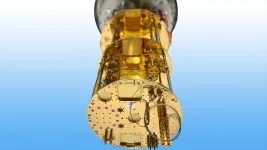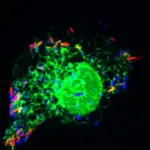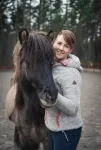(Press-News.org) In cancer, a lot of biology goes awry: Genes mutate, molecular processes change dramatically, and cells proliferate uncontrollably to form entirely new tissues that we call tumors. Multiple things go wrong at different levels, and this complexity is partly what makes cancer so difficult to research and treat.
So it stands to reason that cancer researchers focus their attention where all cancers begin: the genome. If we can understand what happens at the level of DNA, then we can perhaps one day not just treat but even prevent cancers altogether.
This drive has led a team of researchers from EPFL and the University of Lausanne (UNIL) to make a breakthrough discovery concerning a critical genetic aberration that occurs in cancer. Working together, the groups of Elisa Oricchio (EPFL) and Giovanni Ciriello (UNIL) have used a novel algorithm-based method to study how cancer cells re-organize the 3D structure of their DNA in order to ramp up the activity of cancer-promoting genes called "oncogenes." The work is published in two journals, Nature Genetics and Nature Communications.
The research focuses on chromosomes, where our DNA is packaged, and how the chromosomes are organized in the tight space of the cell nucleus. Given that every single one of the billions of cells in our body contains about two meters of DNA, it's understandable that we evolved mechanisms to store it properly. That mechanism involves winding DNA around specialized proteins called histones, like a string spooling around a yoyo.
The resulting super-packed and well-protected DNA-protein complex is called chromatin. Multiple units of chromatin make up the structures we know as chromosomes. Normally, each cell carries 23 chromosomes and two copies for each chromosome, but in cancer cells, their structure and organization change. For example, a piece of a copy of chromosome 8 can be attached to a copy of chromosome 14. Moreover, a chromosome can take on a more relaxed or compact structure, which depends on chemical modifications called "epigenetic marks".
The researchers investigated how changes in specific epigenetic marks modify chromosome structures and the expression of genes that promote tumor growth, known as oncogenes.
Giovanni Ciriello's team at UNIL developed a novel algorithmic approach called Calder (after the American sculptor Alexander Calder) to track how genomic regions are positioned with respect to each other in the nucleus. "We used Calder to compare the spatial organization of the genome in more than a hundred samples," says Ciriello. "But this organization is not static and, just like Alexander Calder's mobile sculptures, it can rearrange its pieces." The researchers used Calder to track regions of chromatin that "moved" from one area of the nucleus to another as a result of changing epigenetic marks.
Meanwhile, Oricchio's team at EPFL used Calder to track changes of the chromatin 3D structure in normal and B-cell lymphoma cells. They discovered that in the lymphoma cells, specific epigenetic changes cause chromatin regions to be repositioned in different areas of the nucleus, which lead to novel local interactions that over-activate the expression of oncogenes.
The also found that, when two fragments from different chromosomes are broken off and swapped, they assume a 3D structure that is distinguishable from the normal copies. Importantly, these changes of 3D structure correspond to different epigenetic marks, and induce high expression of genes that support tumor cell expansion.
"Most of the time we think of our DNA as a long, linear molecule, and it's only recently that we started to understand how its 3D organization is altered in cancer cells," says Oricchio. "Considering the spatial organization of DNA in the nucleus provides a new lens to understand how tumor cells originate, and how therapeutic modulation of epigenetic marks can block tumor progression."
INFORMATION:
Other contributors
Swiss Cancer Center Leman
Swiss Institute of Bioinformatics
Aix Marseille University, CNRS, INSERM
Reference
Stephanie Sungalee, Yuanlong Liu, Ruxandra A. Lambuta, Natalya Katanayeva, Maria Donaldson Collier, Daniele Tavernari, Sandrine Roulland, Giovanni Ciriello, Elisa Oricchio. Histone acetylation dynamics modulate chromatin conformation and allele-specific interactions at oncogenic loci. Nature Genetics 10 May 2021. DOI : 10.1038/s41588-021-00842-x
Yuanlong Liu, Luca Nanni, Stephanie Sungalee, Marie Zufferey, Daniele Tavernari, Marco Mina, Stefano Ceri, Elisa Oricchio, Giovanni Ciriello. Systematic inference and comparison of multi-scale chromatin sub-compartments connects spatial organization to cell phenotypes. Nature Communications 10 May 2021. DOI: 10.1038/s41467-021-22666-3
In the last few years, several technology companies including Google, Microsoft, and IBM, have massively invested in quantum computing systems based on microwave superconducting circuit platforms in an effort to scale them up from small research-oriented systems to commercialized computing platforms. But fulfilling the potential of quantum computers requires a significant increase in the number of qubits, the building blocks of quantum computers, which can store and manipulate quantum information.
But quantum signals can be contaminated by thermal noise generated by the movement of electrons. To prevent this, superconducting quantum systems must operate at ultra-low temperatures - less ...
NEW YORK, NY (May 10, 2021)--Scientists have discovered that many esophageal cancers turn on ancient viral DNA that was embedded in our genome hundreds of millions of years ago.
"It was surprising," says Adam Bass, MD, the Herbert and Florence Irving Professor of Medicine at Columbia University Vagelos College of Physicians and Surgeons and Herbert Irving Comprehensive Cancer Center, who led the study published May 10 in Nature Genetics.
"We weren't specifically searching for the viral elements, but the finding opens up a huge new array of potential cancer targets that I think will be extremely exciting as ways to enhance immunotherapy."
Fossil ...
DALLAS - May 10, 2021 - Scientists at UT Southwestern have discovered a key protein that helps the bacteria that causes Legionnaires' disease to set up house in the cells of humans and other hosts. The findings, published in Science, could offer insights into how other bacteria are able to survive inside cells, knowledge that could lead to new treatments for a wide variety of infections.
"Many infectious bacteria, from listeria to chlamydia to salmonella, use systems that allow them to dwell within their host's cells," says study leader Vincent Tagliabracci, Ph.D., assistant professor of molecular biology at UTSW and member of the Harold C. Simmons Comprehensive Cancer Center. "Better understanding the tools they use to make this happen is teaching us some interesting biochemistry and ...
Many have assumed that the rates of major abdominal surgeries in adults over 65 is increasing over time as the U.S. population ages and as new technology renders surgical procedures safer for older adults. Contrary to this popular belief, a new study from the University of Chicago Medicine found the frequency of abdominal surgery in older adults is decreasing, especially among adults over the age of 85. The study, which examined data from 2002 to 2014, was published May 10 in the Journal of the American Geriatric Society.
While the research was not able to determine the exact reasons for this shift, the results indicate that improvements ...
The relationship a dog has with its owner is related to its stress level. This is the conclusion of a newly published study from Linköping University, Sweden. The results, published in the journal Scientific Reports, also suggest that the link between stress and the owner's personality traits differs between dog breeds.
Researchers at Linköping University have investigated whether the stress levels of dogs are affected by the people they live with. Stress levels for the past several months can be determined in both dogs and humans by measuring the levels of stress hormone stored in hairs as they grow.
The researchers have collected hair from both dogs and owners, and measured levels of cortisol, the most important stress hormone, in them. They were interested in whether there ...
For organizations to reach their potential, they must leverage the expertise of their employees. However, research demonstrates that lower-status employees may not be heard because their "voices" are more likely to be ignored.
New research from the University of Notre Dame is the first to show that peers can help boost marginalized voices, and at the same time benefit their own status, all while helping their organization realize the potential of its employees' diverse perspectives.
Publicly endorsing -- or amplifying -- another person's contribution, while giving attribution to that person, enhances the status of both parties, according to "Amplifying Voice in Organizations," ...
Due to their complexity and microscopic scale, plant-microbe interactions can be quite elusive. Each researcher focuses on a piece of the interaction, and it is hard to find all the pieces let alone assemble them into a comprehensive map to find the hidden treasures within the plant microbiome. This is the purpose of review, to take all the pieces from all the different sources and put them together into something comprehensive that can guide researchers to hidden clues and new associations that unlock the secrets of a system. Like any good treasure map, there are still gaps in the knowledge and the searcher must be clever enough to fill in those gaps to find the "X". Without a map, there is only aimless wandering, but with a map, there is hope of finding the hidden ...
When a loved one dies, memories of that person become particularly valuable in connecting the mourners with the deceased. A new Weill Cornell Medicine online application, called Living Memory Home, offers a virtual and personal memorial space that allows mourners to deposit their memories and feelings about their loss and honor their loved one.
Living Memory Home users are able to create a memorial space that they can personalize with photos and messages. They can customize a virtual cabin and choose an appropriate view. The curated set of questions prompt users to write memories ...
AMES, Iowa - New variants of the SARS-CoV-2 virus most likely will necessitate the development of more vaccine options in the years ahead, and a biomedical scientist at Iowa State University believes the "key" to that development lies in the way the virus binds to human cells.
Michael Cho, a professor of biomedical sciences at Iowa State, is studying how to develop COVID-19 vaccines that target SARS-CoV-2's receptor-binding domain, or the part of the virus that docks with the host cellular receptor, angiotensin converting enzyme 2 (ACE2). This docking process allows the virus access to the host's cells, which leads to infection.
Cho was the lead author of a study recently published in the peer-reviewed scientific journal Frontiers in Immunology detailing the ability of a vaccine ...
Unlike the oscillations of sound waves, the oscillations of light are so fast that extremely complex equipment is needed to observe them directly. However, it is possible to measure the frequencies of these oscillations indirectly with frequency combs. These combs are made up of a set of regularly spaced "teeth" where each tooth corresponds to a frequency. Used as a graduated ruler, they offer the possibility of measuring an optical frequency with great precision. This makes it possible, among other things, to measure variations in the distance between the Earth and the Moon with an accuracy ...





